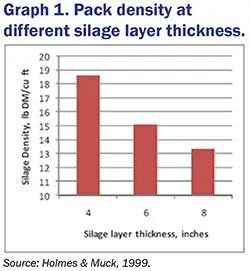
The attraction to compaction
 By Becky Arnold, Lallemand Animal Nutrition territory business manager
By Becky Arnold, Lallemand Animal Nutrition territory business manager
More than ever, farmers and producers must maximize the value of every acre grown. As productive acres become more valuable, so does preserving what has been grown and harvested and maximizing the value of every ton of feed and the ROI per acre.
Packing density is the most important factor influencing silage quality once the crop has been delivered to the silo. An efficient fermentation requires an oxygen-free environment. The more densely packed, the quicker oxygen is depleted, stopping plant respiration and the rapid growth of aerobic spoilage organisms. The longer this takes, the greater the populations of spoilage organisms that will “wake up” at feedout.
 This year’s silage price is somewhere around $55 per ton (in the pit). Using Kurt Ruppel’s research (Table 1), each pound of improvement in packing density is worth 1% dry matter (DM) value recovered, assuming no DM change. Recovering 1% of $55 per ton of silage is no small amount: $55 x 1% = $0.55 x 10,000 ton = $5,500.
This year’s silage price is somewhere around $55 per ton (in the pit). Using Kurt Ruppel’s research (Table 1), each pound of improvement in packing density is worth 1% dry matter (DM) value recovered, assuming no DM change. Recovering 1% of $55 per ton of silage is no small amount: $55 x 1% = $0.55 x 10,000 ton = $5,500.
The recommended packing density is greater than 15 pounds DM per cubic foot or 44 pounds per cubic foot wet/as fed. Ruppel found that 17% to 20% DM is lost if packing density is below 14 pounds DM per cubic foot.
I have spent my career engrossed in this topic and having conversations with producers about the costs associated with not achieving optimal packing density. Although we’ve seen improvements in recent years, packing densities are still below the recommended minimum. So why are the densities not above the bar when the dollar value is indisputable? One could argue it is because the rate of harvest has increased beyond what it costs to effectively do a good job.
 Packing tractors and weight
Packing tractors and weight
You need enough space and tractors to keep up with truck loads. Packers must be able to spread out each load in layers of no greater than 6 inches and completely pack over each layer. If trucks are coming in too fast, the pack operators end up pushing rather than packing.
The “800 Rule” is an easy calculator that may be relevant in some areas today:

For example: 800 x 200 tons per hour = 160,000 pounds or 80 tons of tractor weight.
In most of the western U.S., however, this rule rarely applies. Eighty tons is roughly 3.5 big 4WD weighted tractors. Today’s forage harvesters can cut 320 to 360 tons (or more) per hour. One of today’s choppers would require 5.7 to 6.5 tractors according to the 800 Rule. Having enough space to operate five to seven tractors is a bigger limitation than having access to enough equipment because livestock producers are often limited on space.
 Planning and management
Planning and management
Many factors influence silage density. Harvest moisture, tractor weight and rate of delivery can be somewhat difficult to control, especially if a custom harvesting operation is in play. The key to maximizing densities is managing the controllable factors, like layer thickness and particle length.
Harvesters should increase their tire pressure and use narrower tire widths when possible. Filling the tires with water is frequently done to add more weight. Having skilled operators is vital to building a good pile. The sides and fill ramp should be managed at a 3:1 slope, where tractors can drive over in any direction. When silage is coming in too quickly, lengthen the fill ramp to a 4:1 slope to give packers more room to work each load. Communication throughout the harvest process is critical.
Many equipment options are available (and will be discussed in a future article), but achieving target packing density comes down to the people doing the job and how well they handle what the season brings. Producers and their harvesting partners must agree and communicate the harvesting plan, including goals and expectations. Identify where compromises may be made and define a plan for when circumstances arise. For example, limiting the time it takes to fill the silage pile or bunk has a positive effect on silage quality, but so does packing density. If feed is coming in too fast, will trucks be slowed down, slowing harvesting operations, or is adding another pack tractor or more packing weight a possibility?
Thinking through your goals and the options to achieve them prior to harvest can help you make the best decision when choppers are running.
Editor’s note: This is the first article in a two-part series on silage packing density. In the next article, the author will discuss dual-wheel tractors, track tractors, and pull-type roller packers, and their effects on silage density.
| Category: |
Equipment Facility design Feed quality and nutrition Forage Foundations Forage harvesting Forage storage and management Safety Silages |

